The Dry Electrostatic Wipes Market is estimated to be valued at USD 3.0 billion in 2025 and is projected to reach USD 9.3 billion by 2035, registering a compound annual growth rate (CAGR) of 12.1% over the forecast period.
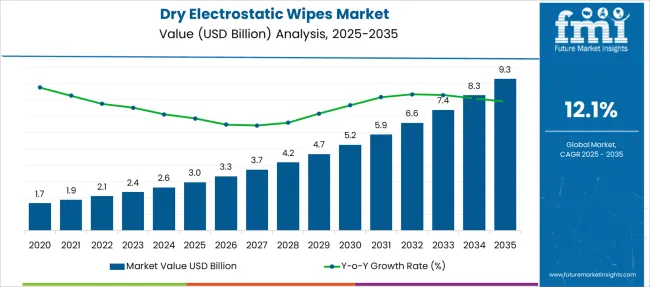
| Metric | Value |
|---|---|
| Dry Electrostatic Wipes Market Estimated Value in (2025 E) | USD 3.0 billion |
| Dry Electrostatic Wipes Market Forecast Value in (2035 F) | USD 9.3 billion |
| Forecast CAGR (2025 to 2035) | 12.1% |
The dry electrostatic wipes market is experiencing accelerated growth due to increasing awareness around surface hygiene, indoor air quality, and allergen control. These wipes have become an integral part of residential and commercial cleaning routines owing to their ability to attract fine particles through static electricity without the need for added chemicals.
The market is being influenced by shifting consumer preferences toward eco-friendly and time-saving products, particularly in regions where air quality concerns and asthma cases are prevalent. Advancements in material engineering and manufacturing techniques have enabled the development of high-performance nonwoven fabrics that enhance dust retention and cleaning efficiency.
Retail brands are also emphasizing fragrance-free and reusable product lines, responding to the growing demand for safe and sustainable alternatives to wet cleaning products With increased household spending on home care and a surge in online retail availability, the market is expected to see consistent expansion across developed and emerging economies, particularly in urban centers where fast and efficient cleaning solutions are prioritized.
The market is segmented by Material Type, Packaging, End-User, and Price Range and region. By Material Type, the market is divided into Knitted, Nonwoven, and Woven. In terms of Packaging, the market is classified into 60-80 Wipes/Bag, Below 20 Wipes/Bag, 30-50 Wipes/Bag, 80-100 Wipes/Bag, and 100 And More Wipes/Bag. Based on End-User, the market is segmented into Residential and Commercial. By Price Range, the market is divided into Economical, Mid-Range, and High. Regionally, the market is classified into North America, Latin America, Western Europe, Eastern Europe, Balkan & Baltic Countries, Russia & Belarus, Central Asia, East Asia, South Asia & Pacific, and the Middle East & Africa.
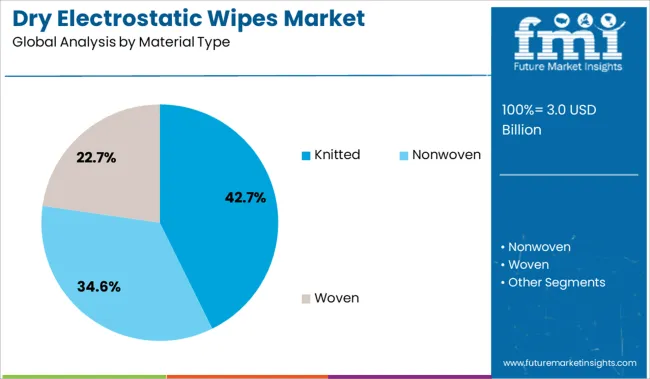
The knitted material segment is projected to hold 42.7% of the total revenue share in the dry electrostatic wipes market in 2025, positioning it as the leading material type. This dominance is being driven by the superior dust-trapping capabilities and reusability associated with knitted fabrics. The interlocking loops of the knitted structure allow for better particle capture, especially fine dust and allergens, without the need for synthetic adhesives or chemical treatments.
These wipes offer enhanced tensile strength, making them suitable for repeated use across various surfaces including floors, furniture, and electronics. Manufacturers have prioritized knitted formats due to their compatibility with electrostatic charging processes that improve dust attraction and retention.
The softness and flexibility of knitted materials have also made them more appealing for households with delicate surfaces, contributing to their wider adoption in residential settings As consumers increasingly demand efficient and eco-conscious cleaning options, knitted electrostatic wipes have emerged as a preferred solution for both performance and sustainability.
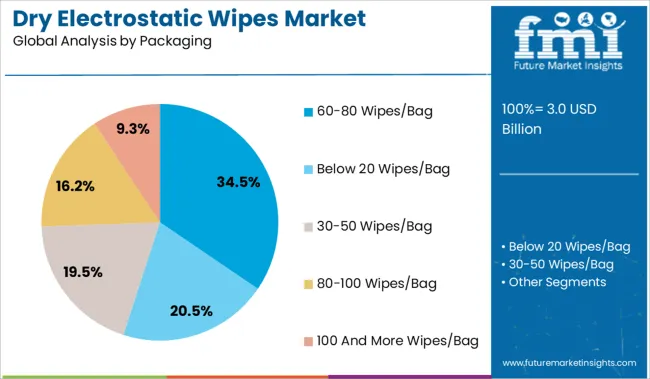
The 60 to 80 wipes per bag packaging format is estimated to account for 34.5% of the overall revenue share in 2025, establishing it as the most preferred packaging configuration in the market. This preference is supported by the balance it offers between cost-effectiveness and convenience for regular household usage. Packs within this range are viewed as sufficient for moderate to high-frequency cleaning routines without creating storage or expiration concerns.
Retailers have focused on this pack size to cater to consumers who seek a practical solution that ensures product freshness over time while minimizing waste. The format is also aligned with retail pricing strategies that appeal to cost-conscious buyers seeking value without compromising quality.
Packaging automation and eco-friendly materials have further optimized this segment, enabling manufacturers to deliver compact, resealable, and user-friendly products As demand continues to grow for ready-to-use, easy-to-store wipes that support daily cleaning needs, this pack size remains the optimal choice for many households.
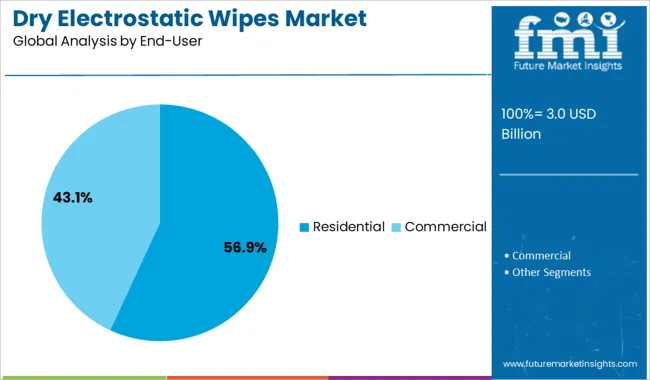
The residential segment is forecast to contribute 56.9% of the total revenue share in the dry electrostatic wipes market in 2025, marking it as the largest end-user category. This leadership is attributed to increased consumer focus on home hygiene, especially in urban households where time-efficient cleaning is highly valued. The rise in dual-income families, compact living spaces, and pet ownership has driven the demand for quick and effective cleaning solutions that require minimal effort.
Dry electrostatic wipes are being adopted widely in residential settings due to their ease of use, chemical-free composition, and strong effectiveness in removing everyday dust and debris. The surge in e-commerce platforms and home care subscription services has further enabled access and awareness among consumers, reinforcing product visibility and adoption.
Seasonal increases in dust and allergen levels have also contributed to routine wipe usage across living areas, electronics, and furniture As homeowners continue to prioritize cleanliness and convenience, the residential sector is expected to remain the cornerstone of market demand.
Consumers are looking for products that save time as their lifestyles change. As a result, demand for nonwoven cleaning wipes is rapidly increasing. Companies are increasingly investing in Research and Development activities in order to expand their product portfolio through new product launches. These are some of the factors that will influence the dry electrostatic wipes market's growth in the near future.
Rapid new product development leading to the introduction of task-specific performance features, rapidly growing advanced nonwoven base technology, and frequently changing consumer purchasing habits due to product availability, innovation, and financial considerations are some of the other factors fueling the growth of the dry electrostatic wipes market during the forecast period.
Other important factors that may impede the growth of the dry electrostatic wipes market during the forecast period include the availability of alternatives to dry electrostatic wipes and the high cost of disposable wipes compared to conventional shop towels.
In 2024, the Asia Pacific market was worth USD 1.3 Billion. Because of increased consumer spending and rising middle-class income, Asia Pacific is expected to dominate the Dry Electrostatic Wipes market share region. Large infant populations in India and China, combined with shifting purchasing preferences for premium baby care items, drive up demand for baby sanitary products.
The large concentration of residential living facilities in India, Singapore, and China drives household cleaning and sanitary item consumption even further. India and China, are experiencing rapid economic and industrialization expansion, which will open up new markets for dry electrostatic wipes used in various manufacturing processes.
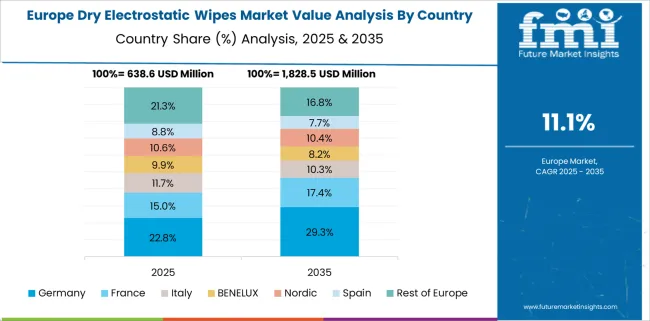
Because of the growing infrastructural facilities of hotels and hospitality, as well as the region's increasing tourist arrivals, the European region accounts for a sizable share of the market. For example, the World Bank Group estimated that nearly 32 million international tourists visited Austria in the previous year, a 3.5% increase over the previous year.
The strong presence of various types of manufacturing plant set-ups in countries such as the United Kingdom, Germany, Spain, and Italy drives the consumption of Dry electrostatic wipes products. Germany is the leading market, with a CAGR of 7.5% projected from 2025 to 2035.
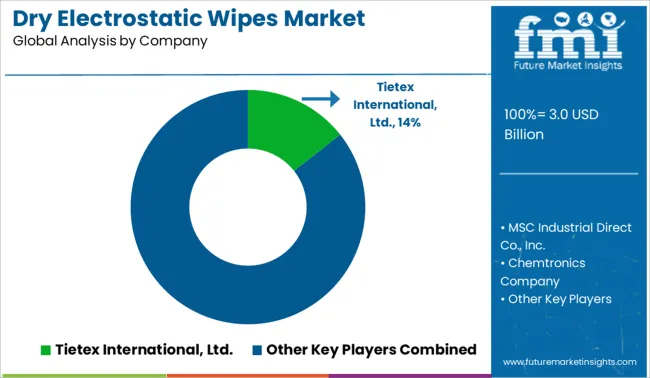
Kimberly-Clark Worldwide, Inc., Chemtronics Company, Electrocomponents PLC, SDI Systems Division, Inc., Pascoes Pty Ltd., Procter Gamble Co., Contec, Inc., and Butler Home Products, LLC are some of the key players in the global dry electrostatic wipes market. Demand for dry electrostatic wipes from electronics manufacturers, medical device manufacturers, and other industries where managing electrostatic charge buildup is critical will rise during the forecast period.
| Report Attribute | Details |
|---|---|
| Growth Rate | CAGR of 12.1% from 2025 to 2035 |
| Base Year for Estimation | 2024 |
| Historical Data | 2020 to 2024 |
| Forecast Period | 2025 to 2035 |
| Quantitative Units | Revenue in USD Billion, Volume in Kilotons, and CAGR from 2025 to 2035 |
| Report Coverage | Revenue Forecast, Volume Forecast, Company Ranking, Competitive Landscape, Growth Factors, Trends, and Pricing Analysis |
| Segments Covered | Sales Channel, Packaging, Material, Region |
| Regions Covered | North America; Latin America; Western Europe; Eastern Europe; Asia Pacific Excluding Japan; Japan; Middle East and Africa |
| Key Countries Profiled | USA, Canada, Brazil, Argentina, Germany, United Kingdom, France, Spain, Australia & New Zealand, China, India, ASIAN, South Africa |
| Key Companies Profiled | Kimberly-Clark Worldwide Inc.; Chemtronics Company; Electrocomponents PLC; SDI Systems Division Inc.; Pascoes Pty Ltd.; Procter Gamble Co.; Contec Inc.; Butler Home |
| Customization | Available Upon Request |
The global dry electrostatic wipes market is estimated to be valued at USD 3.0 billion in 2025.
The market size for the dry electrostatic wipes market is projected to reach USD 9.3 billion by 2035.
The dry electrostatic wipes market is expected to grow at a 12.1% CAGR between 2025 and 2035.
The key product types in dry electrostatic wipes market are knitted, nonwoven and woven.
In terms of packaging, 60-80 wipes/bag segment to command 34.5% share in the dry electrostatic wipes market in 2025.






Full Research Suite comprises of:
Market outlook & trends analysis
Interviews & case studies
Strategic recommendations
Vendor profiles & capabilities analysis
5-year forecasts
8 regions and 60+ country-level data splits
Market segment data splits
12 months of continuous data updates
DELIVERED AS:
PDF EXCEL ONLINE
Dry-type Air-core Smoothing Reactor Market Size and Share Forecast Outlook 2025 to 2035
Dry Powder Inhaler Market Size and Share Forecast Outlook 2025 to 2035
Dry Vacuum Pumps Market Size and Share Forecast Outlook 2025 to 2035
Dry Cleaning Solvents Market Size and Share Forecast Outlook 2025 to 2035
Dry Block Heaters Market Size and Share Forecast Outlook 2025 to 2035
Dry Fog Dust Suppression Equipment Market Size and Share Forecast Outlook 2025 to 2035
Dry Scalp Treatment Market Size and Share Forecast Outlook 2025 to 2035
Dry Type Distribution Transformer Market Size and Share Forecast Outlook 2025 to 2035
Dry Type Current Transformer Market Size and Share Forecast Outlook 2025 to 2035
Dry Eye Syndrome Treatment Market Size and Share Forecast Outlook 2025 to 2035
Dry Type Automated Solar Panel Cleaning Market Size and Share Forecast Outlook 2025 to 2035
Dry Herb Cannabis Vaporizers Market Size and Share Forecast Outlook 2025 to 2035
Dry Type Transformer Market Size and Share Forecast Outlook 2025 to 2035
Dry Whole Milk Powder Market Size and Share Forecast Outlook 2025 to 2035
Dry Gas Coupling Market Analysis Size and Share Forecast Outlook 2025 to 2035
Dry Mixes Market Analysis - Size, Share and Forecast Outlook 2025 to 2035
Dryer Sheets Market Size and Share Forecast Outlook 2025 to 2035
Drylab Photo Printing Market Size and Share Forecast Outlook 2025 to 2035
Dry Yeast Market Report - Size, Demand & Forecast 2025 to 2035
Dry Vacuum Cleaner Market Size and Share Forecast Outlook 2025 to 2035

Thank you!
You will receive an email from our Business Development Manager. Please be sure to check your SPAM/JUNK folder too.
Chat With
MaRIA